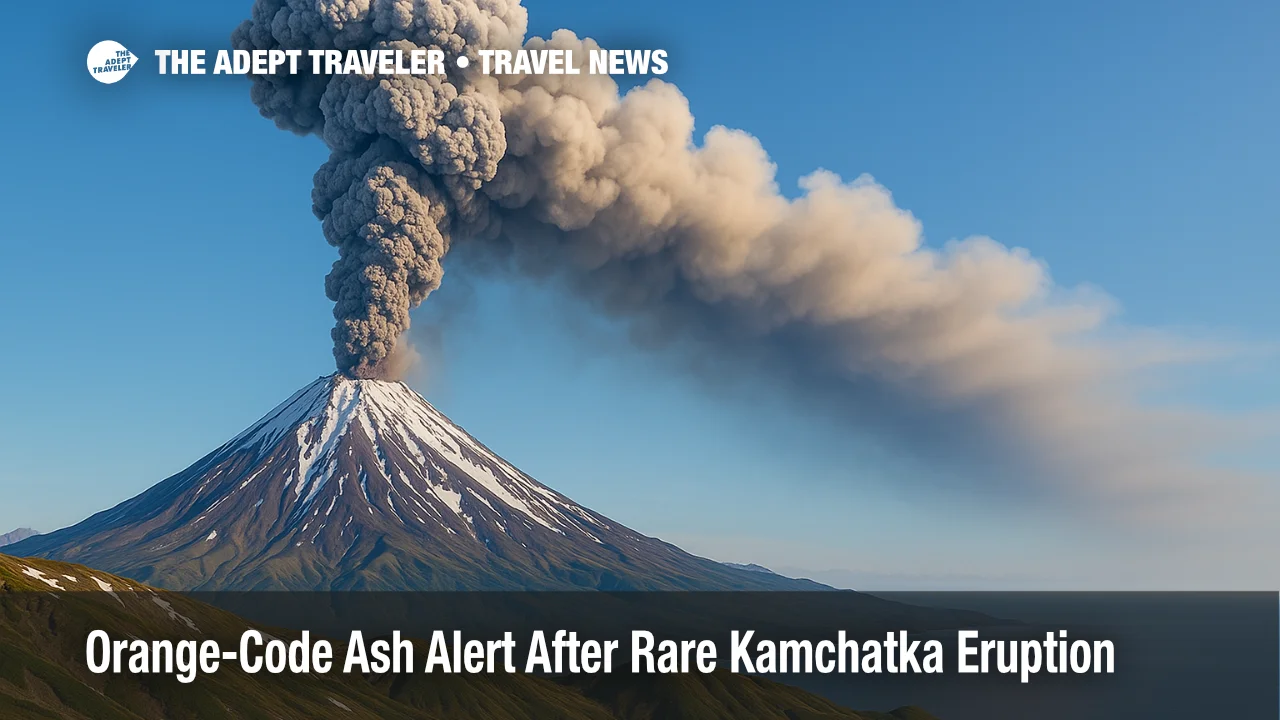Orange-Code Ash Alert After Rare Kamchatka Volcano Eruption

Krasheninnikov on Russia's Kamchatka Peninsula erupted overnight, its first confirmed activity since the 1500s. The blast lofted ash to roughly 20,000 ft, prompting the Anchorage Volcanic Ash Advisory Center to issue an orange aviation warning for heavily used North Pacific tracks between Japan and Alaska. While the plume is drifting east over open water, airlines and cruise lines are recalculating Monday schedules in case ash drifts toward Port Petropavlovsk or the Tokyo-Anchorage corridor.
Key Points
- Why it matters: Rare eruption triggers orange ash code on busy North Pacific air corridors.
- Travel impact: Airlines may detour south, extending trans-Pacific flights by up to 20 minutes.
- What's next: VAAC and KVERT updates will decide Monday flight routes and whether Petropavlovsk port stays open.
- Marine outlook: Cruise ships repositioning in Northeast Asia eye Petropavlovsk closures and itinerary tweaks.
- Seismic backdrop: Eruption follows an 8.8-magnitude quake, raising regional risk vigilance.
Snapshot
The Kamchatka Volcanic Eruption Response Team (KVERT) reported an ash column reaching 6 km, or about 20,000 ft, soon after the volcano re-awakened at 6 a.m. local time on August 3. The ash has been tracked moving eastward across the Bering Sea, keeping populated areas clear for now. Anchorage VAAC's graphics show the highest-density cloud remaining north of the great-circle routes but within reach of Pacific Jet Stream shear, a scenario that historically forces airlines to sidestep the hazard. Travelers can monitor the latest plume projections on the official VAAC portal. Anchorage VAAC advisory.
Background
Krasheninnikov rises 6,090 ft inside Kronotsky Nature Reserve, about 125 miles northeast of Petropavlovsk-Kamchatsky. Geological records suggest its last lava effusion occurred around 1550, making Sunday's event the first historically observed eruption.The blast followed a magnitude-8.8 earthquake on July 29 that triggered brief tsunami alerts from Hawaii to Chile.Kamchatka hosts more than 30 active cones; nearby Klyuchevskoy also re-erupted last week, underscoring the peninsula's volatile tectonic setting. ICAO's nine Volcanic Ash Advisory Centers, including Anchorage and Tokyo, coordinate alerts that airlines must respect when planning North Pacific tracks linking Tokyo Haneda (HND), Narita (NRT), Anchorage (ANC), and Seattle-Tacoma (SEA).
Latest Developments
Airlines weigh detours along Kamchatka ash corridor
Dispatchers at major trans-Pacific carriers told Reuters that preliminary Monday plans shift routings five to ten degrees south of the usual R220 and NOPAC intersections, adding 10-20 minutes and extra fuel. The largest U.S. cargo operator flying Anchorage-Tokyo sectors has filed contingency tracks that avoid ash projections above FL200. Japan Airlines and All Nippon Airways said they are monitoring VAAC updates and will issue travel waivers if required.
Cruise operators monitor Petropavlovsk shutdown risk
Princess Cruises, Holland America Line, and Viking Ocean each have repositioning voyages scheduled to call at Petropavlovsk-Kamchatsky in September. Agents in the Russian Far East said the port authority may suspend operations if ashfall becomes measurable, though no closures were announced on Sunday. Cruise planners are evaluating alternate tender sites at Yuzhno-Kurilsk or Otaru, Japan, should harbor visibility fall below minimums.
Analysis
Volcanic ash presents a uniquely high-cost risk to aviation because even microscopic particles can sandblast turbine blades, clog pitot tubes, and trigger complete engine flameouts. The 2010 Eyjafjallajökull eruption closed 100,000 European flights and cost airlines $1.8 billion. While Krasheninnikov is far smaller, the timing during peak summer traffic raises exposure on the trans-Pacific's busiest city-pairs: Tokyo-Los Angeles, Seoul-Seattle, and Shanghai-Chicago. Cargo airlines moving e-commerce goods between East Asia, Anchorage hub sort centers, and the U.S. mainland have tight fuel margins; every degree of latitude detour burns roughly 1,000 lb of additional jet-A on a Boeing 777F. The orange code also affects North Pacific military exercises, many of which stage from Joint Base Elmendorf-Richardson in Anchorage. Cruise lines face narrower profit buffers; ash-related port cancellations can lead to statutory passenger compensation and charter-flight repatriations, as seen during Shiveluch's 2023 plume. Regional tourism boards will watch closely because Kamchatka's adventure-travel sector had been marketing 2026 eclipse tours that rely on Petropavlovsk's airport (PKC) and harbor.
Final Thoughts
The Kamchatka volcano eruption underlines how a single geologic event can ripple across global travel networks. Even with low immediate threat to populated areas, ash hazards force cautious airlines to re-route, cruise lines to hold contingency plans, and travelers to brace for schedule changes. Monitoring authoritative updates and allowing schedule buffers remain the smartest moves until the ash disperses or Krasheninnikov returns to dormancy. For now, the North Pacific's resilience hinges on agile responses to this Kamchatka volcano eruption.
